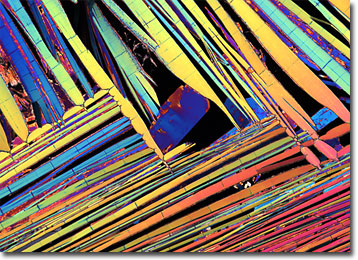Polarized Light Microscopy Digital Image Gallery
Nalidixic Acid
Nalidixic acid is an antibiotic that is almost solely utilized to treat urinary tract infections. The substance is often more commonly known by the brand name NegGram in the United States and Canada.

George Lesher discovered nalidixic acid, the first of the quinolone antibiotics, in 1962 when he and coworkers were attempting to synthesize the anti-malaria drug chloroquine. Due to various factors, nalidixic acid was soon found to only exhibit activity against gram-negative bacteria inhabiting the human urinary tract. Available in liquid and caplet form for oral consumption, the drug works by interfering with the DNA of bacteria, effectively preventing the microorganisms from reproducing and causing them to eventually die out. In addition, the compound is important as the forerunner of all members of the family of topoisomerase inhibitors, many of the more recently developed of which exhibit a broad spectrum of activity.
The name of nalidixic acid is a shortened and altered form of the words naphthyridine and carboxylic acid, which are both elements of one the drug’s chemical names. The antibiotic is usually taken four times a day for one to two weeks, though it is sometimes prescribed in smaller dosages for longer periods of time. Side effects from taking nalidixic acid are uncommon, but may include abdominal pain, vomiting, headache, weakness, dizziness, and confusion. If more serious effects, such as skin rash, swelling of the lips or tongue, or seizures occur, a doctor should be notified immediately.
